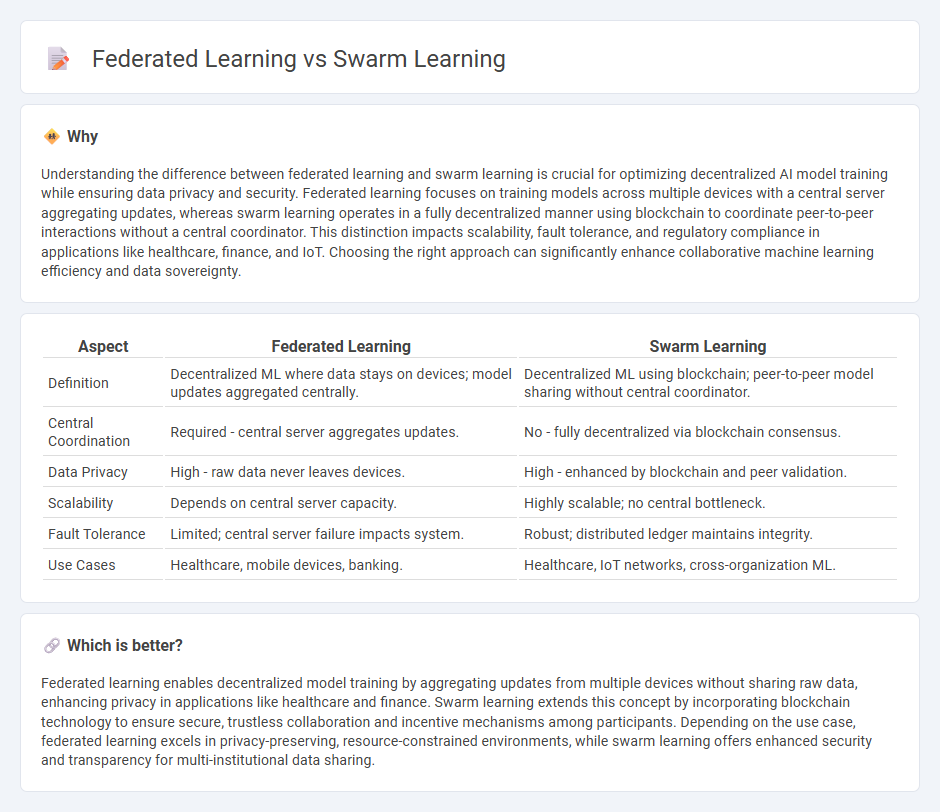
Federated learning enables decentralized model training across multiple devices while preserving data privacy by keeping data local. Swarm learning extends this concept by incorporating blockchain technology to coordinate decentralized models without a central server, enhancing security and scalability. Discover in-depth comparisons and applications of federated and swarm learning to explore their impact on future AI development.
Why it is important
Understanding the difference between federated learning and swarm learning is crucial for optimizing decentralized AI model training while ensuring data privacy and security. Federated learning focuses on training models across multiple devices with a central server aggregating updates, whereas swarm learning operates in a fully decentralized manner using blockchain to coordinate peer-to-peer interactions without a central coordinator. This distinction impacts scalability, fault tolerance, and regulatory compliance in applications like healthcare, finance, and IoT. Choosing the right approach can significantly enhance collaborative machine learning efficiency and data sovereignty.
Comparison Table
| Aspect | Federated Learning | Swarm Learning |
|---|---|---|
| Definition | Decentralized ML where data stays on devices; model updates aggregated centrally. | Decentralized ML using blockchain; peer-to-peer model sharing without central coordinator. |
| Central Coordination | Required - central server aggregates updates. | No - fully decentralized via blockchain consensus. |
| Data Privacy | High - raw data never leaves devices. | High - enhanced by blockchain and peer validation. |
| Scalability | Depends on central server capacity. | Highly scalable; no central bottleneck. |
| Fault Tolerance | Limited; central server failure impacts system. | Robust; distributed ledger maintains integrity. |
| Use Cases | Healthcare, mobile devices, banking. | Healthcare, IoT networks, cross-organization ML. |
Which is better?
Federated learning enables decentralized model training by aggregating updates from multiple devices without sharing raw data, enhancing privacy in applications like healthcare and finance. Swarm learning extends this concept by incorporating blockchain technology to ensure secure, trustless collaboration and incentive mechanisms among participants. Depending on the use case, federated learning excels in privacy-preserving, resource-constrained environments, while swarm learning offers enhanced security and transparency for multi-institutional data sharing.
Connection
Federated learning and swarm learning both enable collaborative machine learning across decentralized devices while preserving data privacy. Federated learning aggregates model updates from multiple clients without sharing raw data, enhancing security in distributed networks. Swarm learning extends this concept by combining blockchain technology to enable peer-to-peer model sharing and consensus, increasing robustness and scalability in decentralized AI systems.
Key Terms
Decentralization
Swarm learning enhances decentralization by enabling peer-to-peer model training without relying on a central server, contrasting with federated learning's client-server architecture where a central aggregator coordinates updates. This decentralized approach in swarm learning increases privacy and resilience by distributing control across participating nodes on blockchain infrastructure. Explore more about the benefits of decentralization in these collaborative machine learning frameworks.
Data Privacy
Swarm learning and federated learning both enhance data privacy by enabling decentralized machine learning without sharing raw data, yet swarm learning leverages blockchain technology for secure and transparent model updates among peers. Federated learning relies on a central server to aggregate model parameters, which can introduce a single point of failure or attack risk, while swarm learning's decentralized approach mitigates these vulnerabilities. Explore more about how these techniques redefine privacy-preserving AI in distributed environments.
Model Aggregation
Swarm learning leverages decentralized model aggregation through blockchain technology, enabling secure, peer-to-peer sharing of learned parameters without a central server, which enhances data privacy and robustness. Federated learning relies on a centralized server to aggregate model updates from distributed clients, potentially creating a single point of failure and privacy vulnerability. Explore detailed comparisons to understand how model aggregation strategies impact scalability and security in distributed learning frameworks.
Source and External Links
HewlettPackard/swarm-learning: A simplified library for ... - Swarm Learning is a decentralized, privacy-preserving Machine Learning framework that uses edge computing and blockchain to enable collaborative model training without sharing raw data, enhancing security and privacy.
What is Swarm Learning? | Glossary - Swarm Learning enables multiple organizations to share machine learning insights peer-to-peer using edge computing and blockchain, allowing collective learning while keeping original data private and compliant with regulations.
HPE Swarm Learning - HPE Swarm Learning is a decentralized ML framework where training occurs locally at data sources, and only model insights (not data) are shared via blockchain, supporting platforms like PyTorch and Keras.
 dowidth.com
dowidth.com